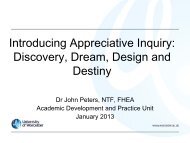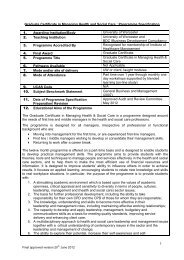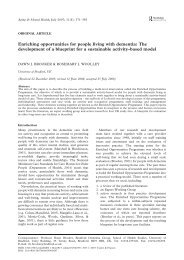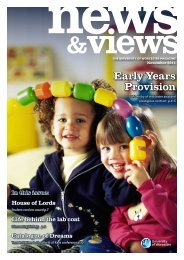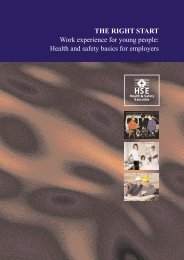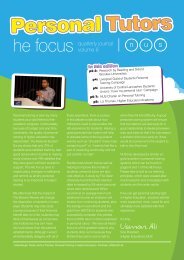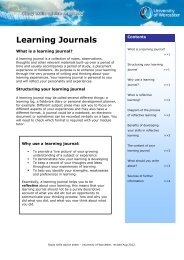Including children with cerebral palsy in mainstream physical
Including children with cerebral palsy in mainstream physical
Including children with cerebral palsy in mainstream physical
You also want an ePaper? Increase the reach of your titles
YUMPU automatically turns print PDFs into web optimized ePapers that Google loves.
Hilderley & Rh<strong>in</strong>d<br />
<strong>Includ<strong>in</strong>g</strong> <strong>children</strong> <strong>with</strong> cp <strong>in</strong> <strong>physical</strong> education<br />
Improved mobility was the only <strong>physical</strong> benefit cited by the participants. This may<br />
be of particular importance as <strong>in</strong>activity can lead to decondition<strong>in</strong>g <strong>in</strong> people <strong>with</strong> CP<br />
which <strong>in</strong> turn contributes to reduced mobility. As <strong>children</strong> <strong>with</strong> CP are significantly<br />
weaker than their able-bodied counterparts (Murphy & Carbone, 2008), there may be<br />
merit <strong>in</strong> emphasiz<strong>in</strong>g the possible <strong>physical</strong> benefits of activity.<br />
Fundamental environmental barriers regard<strong>in</strong>g the appropriateness of the equipment<br />
and accessibility of the facilities were also considered. Clearly, a child <strong>with</strong> CP<br />
should be contextually <strong>in</strong>cluded <strong>in</strong> all aspects of <strong>physical</strong> education and not just <strong>in</strong><br />
the specific activities be<strong>in</strong>g conducted. Provid<strong>in</strong>g age-<strong>in</strong>appropriate equipment may<br />
serve to promote exclusion from the social group and facilitate stigmatization. In<br />
relation to organizational barriers, there are certa<strong>in</strong> constra<strong>in</strong>ts such as health and<br />
safety regulations, and class sizes which key stakeholders have to work <strong>with</strong><strong>in</strong>.<br />
However, there are some organizational, school-level, factors which can represent<br />
barriers. With<strong>in</strong> the present sample, all <strong>children</strong> <strong>with</strong> CP had worked <strong>with</strong> a support<br />
worker which enabled their <strong>in</strong>clusion. Even the most highly effective teacher can f<strong>in</strong>d<br />
<strong>in</strong>clusion difficult <strong>with</strong>out the help of a support worker (LaMaster et al.,1998). The<br />
present research supports the f<strong>in</strong>d<strong>in</strong>gs of Spencer-Cavaliere (2010) who found that<br />
the actions of others had a significant impact on the effectiveness of <strong>in</strong>clusion.<br />
Through tra<strong>in</strong><strong>in</strong>g and educat<strong>in</strong>g teachers and support staff, a school can create an<br />
<strong>in</strong>clusive organization which allows the child to participate.<br />
The barriers represented by the disability itself, such as poor balance and strength,<br />
support those identified <strong>in</strong> previous research (Damiano et al., 2002). It is important,<br />
however, for people <strong>with</strong> CP to ma<strong>in</strong>ta<strong>in</strong> a good level of <strong>physical</strong> fitness to help<br />
reduce the onset of these potential <strong>physical</strong> barriers (Rimmer, 2001). The attitudes of<br />
everyone <strong>in</strong>volved appeared to play a fundamental role. Interest<strong>in</strong>gly, the attitudes of<br />
peers, support workers, teachers and, <strong>in</strong> particular, the child, could all represent<br />
significant barriers or ways <strong>in</strong> which barriers could be overcome.<br />
Summary of Applied Implications<br />
Based on the present study, some tentative recommendations can be made. All<br />
stakeholders can be educated around the range of potential psychological, social<br />
and <strong>physical</strong> benefits of participation. This can <strong>in</strong>clude pupils <strong>with</strong> CP, their peers,<br />
parents, teachers and support workers. This could be <strong>in</strong>corporated <strong>in</strong>to exist<strong>in</strong>g<br />
tra<strong>in</strong><strong>in</strong>g programmes or delivered via workshops or onl<strong>in</strong>e resources. Knowledge of<br />
these benefits can help to facilitate a positive approach to address<strong>in</strong>g the potential<br />
barriers. The participants highlighted that some barriers are difficult to overcome but<br />
can be worked around. Other barriers, such as those related to attitudes and<br />
facilities, can be addressed.<br />
The f<strong>in</strong>d<strong>in</strong>gs of this study suggest <strong>in</strong>clusion does not always require participation <strong>in</strong><br />
the same activities alongside peers. The students felt <strong>in</strong>cluded when they were<br />
officiat<strong>in</strong>g, complet<strong>in</strong>g adapted activities or even spectat<strong>in</strong>g. They accepted they<br />
were different and had <strong>physical</strong> limitations. Thus, <strong>in</strong>clusion does not mean mak<strong>in</strong>g a<br />
child participate <strong>in</strong> the <strong>physical</strong> activity at all costs. It means communicat<strong>in</strong>g <strong>with</strong> the<br />
child and encourag<strong>in</strong>g them to participate <strong>in</strong> some capacity as often as possible.<br />
© 2012 GJSEPER 12



